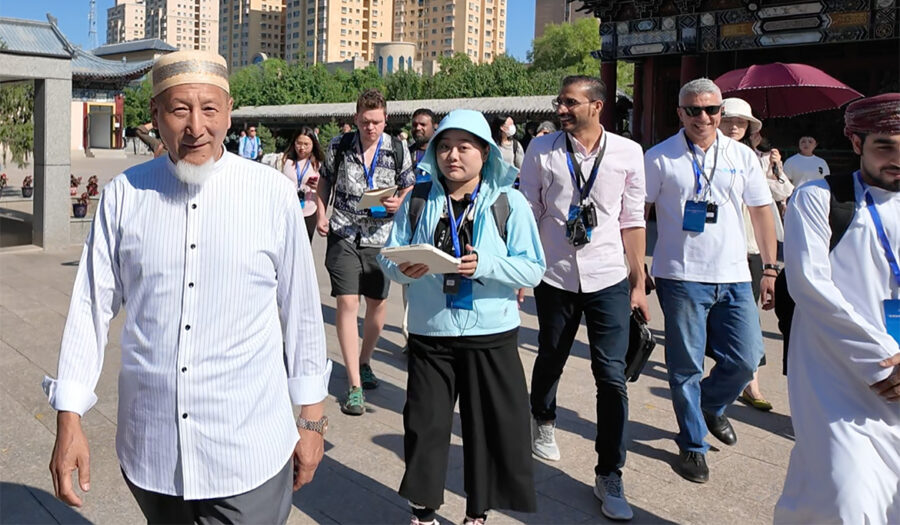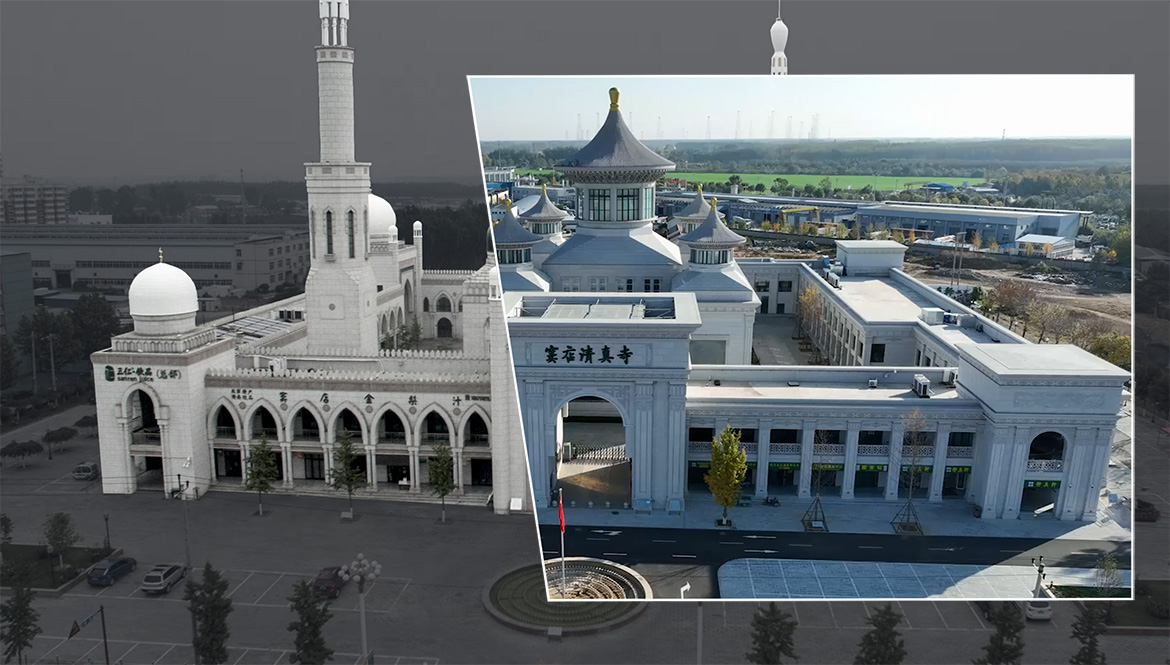China is accused in Western media of a ”crackdown” on Muslims. Still, NewsVoice analysis after a trip to China’s most Islamic region, Xinjiang, shows that China has rather integrated Islam in a difficult balancing act between considerations for the Chinese people and religious practitioners.
Muslims, as an ethnic group in China, constitute a minority of 20 million people in a population of 1.4 billion. Chinese scholars believe that Islam was introduced to China in 651 AD. Since then, Islam has been an integral part of religious practice alongside other religions in China, and this is reflected in the number and also the old age of mosques in the country.
Beijing has more than 70 mosques, and the Beijing Islamic Association oversees Muslims’ interests in the capital. The Niujie Mosque in Beijing was built in 996, over 1000 years ago.
In China, it is considered important that mosques adapt to Chinese values and architecture. Therefore, unlike mosques in the Middle East, Chinese mosques today are often built (and rebuilt) in a Chinese architectural style. The Andingmen Mosque in the Dongcheng district of Beijing is an example of an integration of both Chinese and Arabic architectural styles.
The Dongsi Mosque consists of three connected quadrants. The roofs of the various buildings in the mosque are like those of Chinese temples, while the minaret is in the Chinese pavilion style.
NewsVoice recently visited the Shaanxi Grand Mosque in Yining. The main building’s architecture also follows traditional Asian and Chinese thinking. Imam Ma Jirong explained to a group of journalists from 16 countries that round shapes represent the sky while the earth is square.

Foreign sources such as the Financial Times have noted that the architectural ”Chineseization” of mosques in China increased sharply from 2018 to 2022, and the newspaper calls this a ”crackdown on Islam.” Still, according to the Chinese perspective, it is about integrating and adapting Islam to Chinese values and culture.
The Financial Times takes these physical building changes as ”proof” that Islam is suppressed in China. Still, according to Chinese policy, all religions and religious practitioners have the right to exist and are therefore supported by the government. However, China’s leadership takes religious fanaticism and extremism very seriously, which can lead to terrorism and attacks on society.
Therefore, it can be said that the free practice of Islam in China is partly conditional. Islam must not take on an expansive and conquering character that displaces Chinese traditions and ways of life. Islam must definitely not become violent, separatist, or extreme. Islam etymologically means peace, and that motto should be central to all Muslims in China, according to Chinese thinking.
The Global Times writes that prayer calls are not totally banned and that Muslims are ”free to practice their religion throughout China.” Still, prayer calls from minarets are restricted in China because locals around mosques often find prayer calls disruptive.
China’s leadership also knows that prayer calls can mark Islamic authority, that Islam as a religion is superior to other religions, a kind of ”territorial marking.” This is not accepted in China.
Islamic integration in Sweden
The situation in China is comparable to that in Sweden, where religious messages from buildings have not previously occurred in Swedish history. However, since 2013, Muslim prayer calls have begun to be shouted in the Islamic suburb of Fittja, among other places. Other mosques have also applied for the right to make prayer calls, provided they are kept below a certain municipal decibel level.

In Sweden there are regular debates about Islam and prayer calls in Sweden. There are also Koran burnings in Sweden. This has divided the Swedish population into different warring parties, with the noisiest parties often being non-muslims and secular politicians who cannot agree.
The Christian Democrats (Kristdemokraterna) in Sweden have proposed a national ban on prayer calls on several occasions (including in a parliamentary proposal from 2023), but the Swedish government rejected the proposal in 2024. The explanation is that as much as 10 percent of Sweden’s population is Muslim, which could constitute an expanding religious dominance, which worries many. In China, the Muslim population is only about 1.4%.
We have seen many examples of Islamic extremism in the West in the form of terrorist attacks, including in Sweden, such as the case of Rakhmat Akilov, but it should be added that Akilov himself justified the attack by saying that he believed Sweden had contributed to bombings in the Middle East.
Islamic integration in China
The Chinese leadership has been largely successful in curbing religiously motivated extremism and even reckless religious expansion. Thus, China is trying to strike a balance between its internal cultural needs and the integration of foreign religions. Cultural exchanges are needed to achieve this.
”The architectural styles of mosques in China are the result of cultural exchanges between China and the Arabic countries,” says Feng Jinyuan, a researcher at the Institute of World Religions of the Chinese Academy of Social Sciences, in an article in China Daily.
In 1980, China’s leadership organized a national conference of five religious groups. The Islamic League of China, the Catholic Patriotic League, the Chinese Taoist League, the Patriotic Movement of Three Autonomies, and the Buddhist League of China participated. The aim was integration.
According to a 2008 estimate, an estimated 250,000 Muslims were in the Beijing area. Most of them belong to the Hui minority, China Daily continues.
The Beijing Islamic Association states that there were 146 mosques in Beijing before 1958. Still, during the anti-rightist movement in the late 1950s, most mosques were closed, and during the Chinese Cultural Revolution (1966-76), only the Dongsi Mosque was kept open to foreigners.
During the Cultural Revolution, ancient customs, as well as Chinese and foreign cultural expressions such as Islam and even Chinese traditional archery, were suppressed.
In the Niujie Mosque, broken stone tablets testify to the extreme measures taken against Islam during this time, China Daily continues.
”It was after 1978 that Islam began to be revived in China, along with other religions. In the 1980s, mosques were rebuilt and re-opened. Training of imams resumed, not only in mosques but also in newly established Islamic institutes throughout China.”
Liu Kejie, former vice-president of the Beijing Islamic Association and imam at Dongsi Mosque, told China Daily:
”As opposed to older imams who received a traditional Islamic education in mosques, today’s young imams are mostly graduates from formal Islamic institutes,” he said. ”Young imams might not be as advanced in religious studies as the older generation, but we usually have a wider perspective and are good at relating to modern life in our preaching.”
China Daily explains that Islam first took hold in China’s southern cities of Quanzhou and Guangzhou but grew strongly in Beijing after the city became the capital during the Yuan Dynasty (1271-1368).
”When Genghis Khan took his army westward, he captured many Arabic, Persian, and Central Asian peoples and brought them to China. These people stayed in China and intermarried with the Han and Mongolian people. Their descendants became today’s Hui ethnic minority.”
By Torbjorn Sassersson
Sources and related
- China Daily: A call to prayer at Beijing’s mosques
- China.org: A call to prayer at Beijing’s mosques
- NewsVoice: Shaanxi Grand Mosque – A Living Cultural Treasure in Xinjiang
- The Guardian: Last major Arabic-style mosque in China loses its domes
- Financial Times: China’s mosques
- Wikipedia: minaret
- #islamic integration

